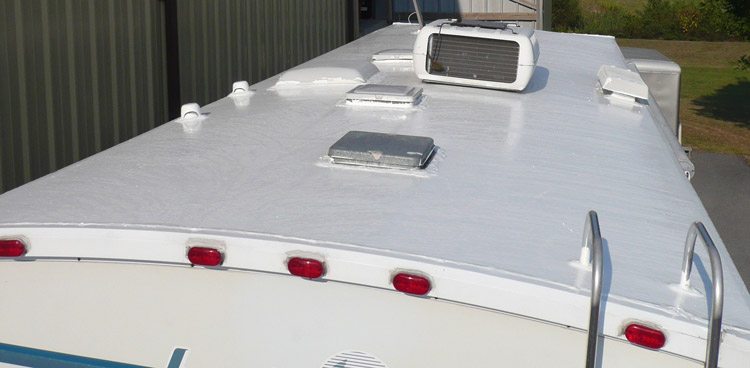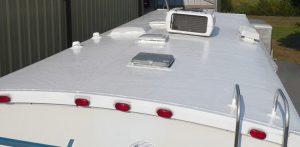

Depending on the type of roof your RV has, applying a coating over the top of it could be the very best way to extend the life of your roof and keep your camper in tip-top shape.
That said, many people have no idea where to begin when choosing and applying a coating to their RV roof. Because of this, many people choose to ignore this chore entirely, something that could lead to some serious damage over time.
Looking to apply a new RV roof coating to your rig? This article will address some of the most common questions about RV roof coatings so you can get started with confidence.
Choosing the Best RV Roof Coating
Of course, the first step in applying an RV roof coating is choosing the coating that is right for your needs. There are a number of options out there, but it is important to be aware that certain coatings are meant for certain roof materials, and coatings are not a one-size-fits-all product.
Additionally, we should note that TPO rubber roof should not be coated. Therefore, the rubber roof coatings listed here are all meant for EPDM roofs which are, oddly enough, an entirely different type of roof.
For a Rubber Roof
Below is a list of the top coating products for EPDM rubber roofs. According to RV roof coating reviews, these RV rubber roof coatings do an excellent job or resealing the roof, and will last for years if well taken care of. Just be sure to apply the coating according to the manufacturer’s instructions and you should be good to go!
- Plas-T-Cote RV Roof Coating
- Heng’s Rubber Roof Coating
- Liquid Roof RV Roof Coating and Repair
- Dicor Rubber Roof Coating
For a Metal or Fiberglass Roof
As mentioned before, not all RV roofs are the same, and some roofs will require a different coating product than others. If you do not have a EPDM or TPO rubber roof, it’s likely that you have an aluminum or fiberglass roof. Either of these can be coated with Dicor Elastomeric RV Roof Coating.
This elastomeric RV roof coating product is excellent because it provides a thick waterproof layer that moves with the RV, making it less likely to develop cracks. Besides, it’s super easy to apply, making it even more desirable.
Applying Your RV Roof Coating
Whether you’re applying an RV rubber roof coating or some other type of coating, the process is going to be very similar.
While we can’t give exact instructions for all cases because the directions will change based on the product you use, we can give an idea of what you might need to do. Keep in mind that this is only a rough outline of the process, and you should heed all manufacturer’s instructions and warnings, putting them before the advice you read here.
You will always want to begin by thoroughly cleaning the entire roof and patching any cracks or holes you may find. We find that Eternabond tape is a fabulous product for making these repairs.
Once all repairs are made and the roof is clean, you will apply the product of your choice by brushing it on. Some people prefer to use a paintbrush, while others feel that a roller works better. A roller with a long handle makes the most sense to us, considering the distances you may need to reach.
When you are finished applying the coating, you will probably need to allow plenty of time for it to cure completely before running the air conditioner or exposing it to rain. Allowing the proper amount of dry time is crucial to the effectiveness of your new coating.
This is all you need to know to get started on your RV roof coating project. Go ahead and pick up a product that will work on your roof, and give your RV roof the fresh new look it deserves.
This post may contain affiliate links.

